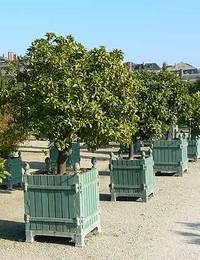Oranges are one of the most popular fruits that are eaten in Britain however, where the original wild plants came from is not certain. It is known that both oranges and citrons were grown in China as early as 2,200 BC.
Seeds and plants may have been carried by merchants or travellers to Iran and Iraq and they were believed to have been grown in the Hanging Gardens of Babylon.
The first oranges grown in southern Europe had a bitter flavour; unlike like the sweet tasting varieties we eat today, and were used for medicinal purposes during the 11th century.
Sweet oranges did not reach Europe until the 16th century, probably brought by Portuguese traders it was only after this period that they then became widely grown.
Because they will not stand severe frosts, they did not come to be grown in Britain until the Baroque period in the 17th century when wealthy landowners created extravagant ‘Orangeries’ to protect them from the winter weather.
Traditionally orange trees growing in large pots are stood in the open air during the summer months; a panel in the front of this greenhouse can be opened to allow tall trees to be easily carried out. They are then returned to the shelter of the Orangery before winter frosts occur.  Oranges, lemons, limes and grapefruits are very ornamental medium sized evergreen shrubs that bear highly scented flowers and large attractive fruits.
Oranges, lemons, limes and grapefruits are very ornamental medium sized evergreen shrubs that bear highly scented flowers and large attractive fruits.
Small lemon trees are very popular plants for the house and conservatory because they will bear both the fruit and their sweet-scented flowers at the same time. Some varieties are tolerant of quite low temperatures although none of them will tolerate heavy frosts.
Scientifically all the different types of orange, lemons and limes belong to the genus Citrus and there are currently around 20 different species recognised by botanists.
Over 70 million tonnes of oranges are grown worldwide for human consumption every year; most of this output is used to make orange juice.
The largest grower in the world is Brazil with around 20 million tonnes of fruit being produced per annum, most of this production is exported.
Citrus sinensis, is the Common Orange and includes the red-fleshed Blood Orange and the Navel Orange. There are over 50 varieties of this species and it is the most widely grown fruit tree in the world.
Citrus aurantium, is well known as ‘Seville Orange’ or ‘Bitter Orange’ and is widely used for making marmalade.
‘Orange County’ in California gets its name from the fact that so many farms went into growing oranges. However, by the mid 1990s urban spread meant that the main production areas in the USA moved away from California to Florida and Brazil.
The word ‘Orange’ is derived from the Sanskrit for the fruit and the colour orange was named after the fruit.
In the 19th century, British sailors were given the nickname ‘Limeys’ because they were given a daily issue of Limes, Citrus aurantiifolia. These citrus fruits were eaten to prevent them getting the disease ‘Scurvy’, which is caused by a lack of vitamin C. Lemons actually contain much more of this vitamin but were less readily available to the British fleet travelling back and forth to the West Indies.
The Lemon, Citrus limon, was introduced to the Mediterranean area about the same time as the Orange. The popular variety ‘Meyer’ is believed to be a hybrid between the true Lemon and the Common Orange. As Citrus plants go, it is reasonably hardy and will stand a few hours at -5C without much damage.
All species of Citrus are inter-fertile and where different species are grown in proximity, seeds taken from fruit are likely to produce hybrids that combine characteristics of each parent plant.
The oils that are contained within the peel of Citrus fruits are widely used in the production of perfumes, medicines and cleaning products.
The Citron, Citrus medica, is a large fruit, frequently much more than 150mm long and wide. It is very different from most of the other edible varieties in that it has an incredibly thick white pith, beneath the thin coloured peel, containing a dry segmented centre where the seeds are found. It has been used for medical purposes since ancient times and has been in cultivation longer than any other species. There is a form of the Citron known as ‘Buddha’s Hand’ in which the fruit has a shape like a large cluster of fingers. Its scientific name is Citrus medica var. digitata.
The Bergamot Citrus bergamia is believed to be a naturally occurring hybrid between the Bitter Orange and the Lime, it is found growing in India and China. A valuable essential is expressed from its peel and it has been used as a base for perfumes, particularly ‘Eau de Cologne’ since 1714. It is also used to give ‘Earl Grey Tea’ its distinctive flavour.
Pomelo (also known as Pampelmousse) Citrus maxima This species, as its scientific name suggests, bears a large fruit which has a thick white pith and sweet juicy seed-filled segments. It used to be widely eaten but has now been replaced by its hybrid offspring the Grapefruit.
Citrus x paradisi, the Grapefruit is best known as a breakfast fruit. It is believed to be a hybrid between the ‘Pomelo’ and Common Orange that was first found in the West Indies by Griffith Hughes a Welshman, in or around 1750
The small, easy to peel, Tangerine, Mandarin, Clementine and Satsuma are all varieties of Citrus reticulata. This species is possibly the most popular of all the edible Citrus fruits and is probably the hardiest of all, having been recorded as surviving -10C without any damage.